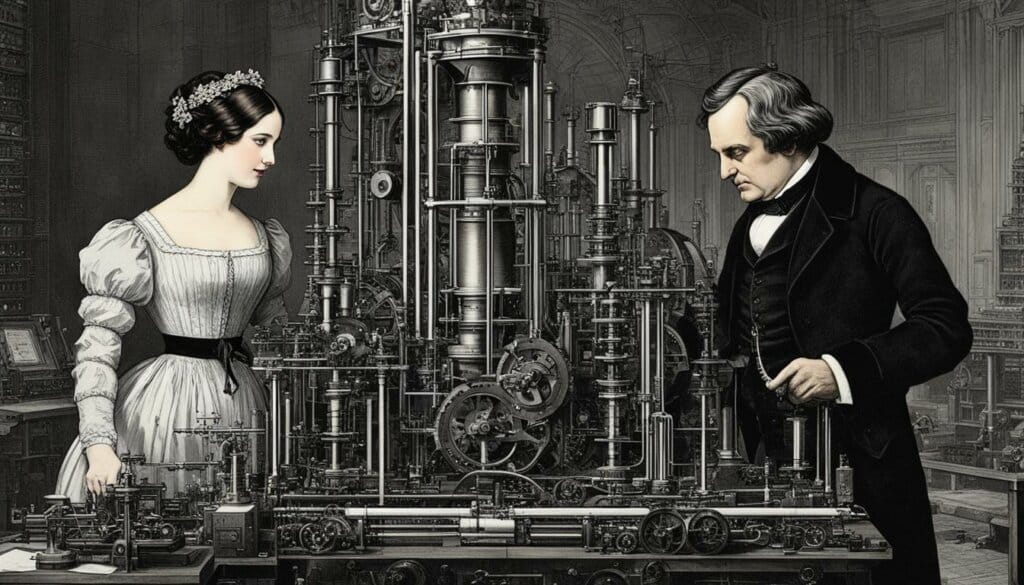Table of Contents
Ada Lovelace, often hailed as the first computer programmer, was a trailblazing figure in the field of computing. Her influential work and contributions to computer science have left an indelible mark on the industry. As one of the early computer scientists and an advocate for the involvement of women in STEM fields, Lovelace’s legacy continues to inspire and empower generations of innovators and influential women in technology.
Ada Lovelace Day, celebrated annually on the second Tuesday of October, commemorates her significant contributions and serves as a reminder of the importance of women in technology. Lovelace’s brilliance and forward-thinking vision are evident in her work on the analytical engine, a precursor to modern computing. Her revolutionary understanding of the machine’s potential to carry out symbolic operations and perform tasks beyond mere numerical calculations laid the foundation for the development of artificial intelligence.
Lovelace’s keen insights and her creation of the first algorithm set a precedent and established a new era in computing history. Her collaboration with renowned inventor Charles Babbage resulted in groundbreaking research and intellectual partnership. Lovelace’s extensive notes on the Analytical Engine not only translated and expanded on Luigi Menabrea’s work but also showcased her ability to envision the future of computing.
Despite her significant contributions, Ada Lovelace’s achievements went largely unrecognized until the 20th century. However, her exceptional intellect, visionary ideas, and undeniable impact on the field of computer science have immortalized her as a computing pioneer and a celebrated figure in the history of technology.
Ada Lovelace’s story serves as a reminder of the barriers she overcame to pursue her passion in a male-dominated field. Today, Lovelace’s legacy remains an inspiration for aspiring women in STEM, encouraging them to challenge stereotypes and make their mark on the world of technology. As we reflect on Lovelace’s contributions to computer science, it becomes clear why she is celebrated as an influential figure whose imprint resonates through the corridors of computing history.
Early Life and Education
Ada Lovelace, the computing pioneer, was born on December 10, 1815, in London, England. She was the daughter of renowned poet Lord Byron and Lady Anne Isabella Milbanke. Lovelace’s early life was marked by privilege but also isolation, as she was raised by her mother and strict grandparents.
Despite her unconventional family background, Lovelace received a comprehensive education from a young age. Her mother, Lady Milbanke, recognized Lovelace’s brilliance and encouraged her to study mathematics and logic. This early exposure fuelled Lovelace’s curiosity and laid the foundation for her profound interest in technology and science.
Throughout her formative years, Lovelace’s fascination with mathematics and logic grew. She honed her analytical skills and developed a remarkable aptitude for problem-solving. This innate talent would later become instrumental in her contributions to the field of computing.
Under the guidance of her tutors and mentors, Lovelace’s intellectual abilities flourished. She delved into the realms of mathematics, learning from distinguished mathematicians of her time and exploring various branches of the subject. Lovelace’s thirst for knowledge was unquenchable, and she constantly sought opportunities to expand her horizons and push the boundaries of her understanding.
By immersing herself in the world of mathematics and logic, Lovelace found a sense of purpose and fulfillment. Her interest in technology and science was not merely academic but deeply ingrained in her being. Lovelace recognized the potential of these disciplines to revolutionize society and drive innovation.
Throughout her early life and education, Lovelace’s passion for mathematics, logic, and her interest in technology converged, setting the stage for her groundbreaking contributions to the field of computer science.
Collaboration with Charles Babbage
Ada Lovelace’s most significant contributions to computer science came through her collaboration with Charles Babbage. She first met Babbage in 1833, and their intellectual partnership led to a profound understanding of Babbage’s Analytical Engine. Lovelace translated and supplemented an article by Luigi Menabrea about the Analytical Engine, which included a set of extensive notes. In these notes, Lovelace described an algorithm that is widely considered the first computer program. She recognized the potential of the Analytical Engine to perform tasks beyond simple calculations and envisioned its use as a tool for creativity and collaboration.

Ada Lovelace’s collaboration with Charles Babbage was instrumental in shaping the field of computer science. Through their partnership, they furthered the development of the Analytical Engine and laid the groundwork for modern computing. Lovelace’s translation and notes provided a deep understanding of the machine’s capabilities, and her algorithm demonstrated the potential for it to execute complex tasks. Her visionary insights into the future of computing, emphasizing its role in creativity and collaboration, set the stage for the technological advancements we see today.
| Collaboration with Charles Babbage Highlights |
|---|
| Translation and supplementation of Luigi Menabrea’s article on the Analytical Engine |
| Description of the first computer program algorithm |
| Recognition of the Analytical Engine’s potential for creativity and collaboration |
| Influential contributions to the development of modern computing |
Lovelace’s Vision and Impact
Ada Lovelace’s visionary ideas and understanding of the Analytical Engine laid the foundation for modern computing. She recognized that computers could perform not only numerical calculations but also symbolic operations. Lovelace’s concept of universal computation, where machines could go beyond predefined tasks to perform complex operations, has proved to be instrumental in the development of artificial intelligence. Her belief that computers could only do what humans instructed them to do is still foundational in the field of AI. The Lovelace Test, proposed in 2001, challenges the idea of true machine intelligence by requiring computers to generate original and independent output.
In Lovelace’s visionary view, computing was not limited to mere numerical calculations. She understood that computers had the potential for universal computation, capable of performing symbolic operations beyond predefined tasks. This profound insight laid the groundwork for the development of artificial intelligence, a field that explores the creation of intelligent machines capable of reasoning and learning.
Lovelace’s understanding of the limitations of early computing machines was groundbreaking. She acknowledged that computers could only execute the instructions provided by humans. This belief remains fundamental in the field of AI, which seeks to develop algorithms and systems that can emulate human intelligence and decision-making processes.
As a testament to Lovelace’s enduring impact, the Lovelace Test was introduced in 2001. Inspired by her visionary ideas, this test established a benchmark for true machine intelligence. By requiring computers to generate original and independent output, the Lovelace Test challenges the notion of AI algorithms being limited to pre-existing knowledge and programmed responses.
Recognition and Legacy
Ada Lovelace’s exceptional contributions to computer science were not widely recognized until the 20th century. Her groundbreaking work, which laid the foundation for modern computing, was reintroduced and acknowledged by Bertram Vivian Bowden in 1953. Lovelace’s significant role in the development of computing was finally acknowledged, cementing her status as a true pioneer in computer programming.
Today, Ada Lovelace is rightfully recognized as a symbol of the important contributions women have made to technology. Her legacy serves as an inspiration for generations of women in technology, empowering them to pursue careers in STEM fields. To commemorate her immense impact, Ada Lovelace Day is celebrated annually on the second Tuesday of October. This special day not only honors her pioneering work but also aims to encourage more women to enter the world of technology and continue advancing the boundaries of computer science.

| Recognition | Legacy | Contributions to Computer Science | Women in Technology |
|---|---|---|---|
| Ada Lovelace’s work acknowledged by Bertram Vivian Bowden, 1953 | A symbol of women’s contributions to technology | Lovelace’s pioneering work laid the foundation for modern computing | Inspires women to pursue careers in STEM fields |
| Reintroduction of Lovelace’s significant role in computing | Ada Lovelace Day celebrates her legacy | Her understanding of the Analytical Engine shaped the development of computer science | Empowers women to make their mark in the technology industry |
| Belated recognition of Lovelace’s groundbreaking contributions | Lovelace’s vision continues to shape the field of technology | Her work paved the way for advancements in artificial intelligence | Encourages diversity and equality in technology |
Conclusion
Ada Lovelace, the pioneering computing genius, has undeniably left an indelible mark on the world of technology. Her visionary insights and grasp of the potential of the Analytical Engine have shaped the development of modern computers and artificial intelligence. Lovelace’s legacy as a prominent woman in the fields of science, technology, engineering, and mathematics (STEM) continues to inspire and empower countless generations of women in the technology industry.
Ada Lovelace’s profound contributions to computing history will forever be remembered and celebrated. As a trailblazer and influential figure, she defied societal norms of her time and deftly navigated the predominantly male-dominated field of technology. Her pioneering work serves as a powerful reminder of the crucial role women have played and continue to play in advancing the world of technology.
Lovelace’s enduring legacy serves as a beacon of inspiration, encouraging women to pursue careers in STEM and champion their rightful place in the world of technology. Her invaluable contributions have not only paved the way for technological advancements but have also shattered stereotypes and paved the path for greater gender equality in the industry. Ada Lovelace’s unwavering presence in the annals of computing history solidifies her status as one of the most influential women in technology, leaving a legacy that continues to shape and transform the world.
FAQ
Who was Ada Lovelace?
Ada Lovelace, also known as Augusta Ada King, Countess of Lovelace, was an English mathematician and writer who is considered the first computer programmer. She made significant contributions to the field of computer science and is an influential figure in the history of computing.
What were Ada Lovelace’s contributions to computer science?
Ada Lovelace’s most significant contribution to computer science was her collaboration with Charles Babbage on his Analytical Engine. She translated and supplemented an article by Luigi Menabrea about the engine, with her own extensive notes. In these notes, Lovelace described an algorithm that is widely considered the first computer program.
What is the Lovelace Test?
The Lovelace Test, proposed in 2001, challenges the idea of true machine intelligence. It requires computers to generate original and independent output, which reflects Lovelace’s belief that computers could only do what humans instructed them to do.
When is Ada Lovelace Day celebrated?
Ada Lovelace Day is celebrated annually on the second Tuesday of October. It is a day to honor Ada Lovelace’s legacy and to inspire more women to pursue careers in science, technology, engineering, and mathematics (STEM) fields.
How did Ada Lovelace’s work impact computing history?
Ada Lovelace’s visionary ideas and understanding of the Analytical Engine laid the foundation for modern computing. She recognized the potential of computers to perform symbolic operations and her concept of universal computation has influenced the development of artificial intelligence algorithms.
Why is Ada Lovelace important to women in STEM?
Ada Lovelace is an influential figure for women in science, technology, engineering, and mathematics (STEM). Her pioneering work in computer programming and her achievements as an early computer scientist serve as an inspiration for women in technology, highlighting the significant contributions they can make to the field.













